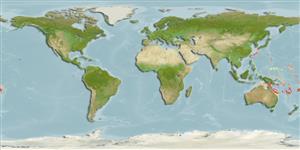Classificação / Names
Nomes comuns | Sinónimos | Catalog of Fishes(Género, Espécies) | ITIS | CoL | WoRMS | Cloffa
>
Perciformes/Scorpaenoidei (Scorpionfishes) >
Scorpaenidae (Scorpionfishes or rockfishes) > Scorpaeninae
Etymology: Scorpaenopsis: Latin, scorpaena = a kind of fish, 1706 + Greek, opsis = appearance (Ref. 45335); eschmeyeri: Named for William N. Eschmeyer, in recognition of his research on the Scorpaenidae.
Eponymy: Dr William Neil ‘Bill’ Eschmeyer (d: 1939) is an American ichthyologist and taxonomist who is now Curator Emeritus, California Academy of Sciences, San Francisco and a Research Associate, Florida Museum of Natural History, Gainesville. [...] (Ref. 128868), visit book page.
More on authors: Randall & Greenfield.
Environment: milieu / climate zone / depth range / distribution range
Ecologia
marinhas demersal; intervalo de profundidade 1 - 24 m (Ref. 57579). Subtropical
Southwestern Pacific: Fiji and New Caledonia.
Tamanho / Peso / Idade
Maturity: Lm ? range ? - ? cm
Max length : 7.6 cm SL macho/indeterminado; (Ref. 57579); 11.5 cm SL (female)
Espinhos dorsais (total) : 12; Raios dorsais moles (total) : 9; Espinhos anais: 3; Raios anais moles: 5. Diagnosis: Dorsal rays XII,9; anal rays III,5; pectoral rays 17-18 (rarely 18). Longitudinal scale series 44--48 (modally 46). Body depth 2.8-3.05 in SL; head length (HL) 2.2-2.3 in SL; snout length 3.0-3.15 in HL; orbit diameter 4.65--4.95 in HL; nearly one-half of orbit extending above dorsal profile of head; interorbital width 6.75-7.2 in HL. Pair of interorbital ridges flaring posteriorly, then curving medially to join slight incurved ridge at front of occipital pit; median interorbital ridge extending half way back in interorbital space; occipital pit shallow and not flat. Coronal spines and pretympanic spines absent. Suborbital pit not well developed; suborbital ridge with 4 spines, the first on lacrimal; two ventral spines on lacrimal, one directed mainly anteriorly and the other curving posteriorly. First dorsal spine 1.9-2.4 in second spine; third dorsal spine longest, 2.2-2.7 in HL; eleventh dorsal spine 1.55-2.0 in twelfth spine; second anal spine 1.65-2.0 in HL. Supraoccipital tentacle absent. Body color variable, the darkest blotches usually above tip of upper opercular spine, two on lateral line, two obliquely above and forward of these, two in soft portion of dorsal fin, and one in anal fin (Ref. 57579).
Inhabits coral reef. Benthic (Ref. 75154).
Life cycle and mating behavior
Maturidade | Reprodução | Desova | Ovos | Fecundidade | Larvas
Randall, J.E. and D.W. Greenfield, 2004. Two new scorpionfishes (Scorpaenidae) from the South Pacific. Proc. Calif. Acad. Sci. 55(9):384-394. (Ref. 57579)
Categoria na Lista Vermelha da IUCN (Ref. 130435: Version 2024-2)
Ameaça para o homem
Venomous
Utilização humana
Ferramentas
Relatórios especiais
Descarregue XML
Fontes da internet
Estimates based on models
Preferred temperature (Ref.
123201): 24.7 - 27.9, mean 26.5 °C (based on 307 cells).
Phylogenetic diversity index (Ref.
82804): PD
50 = 0.5000 [Uniqueness, from 0.5 = low to 2.0 = high].
Bayesian length-weight: a=0.01288 (0.00620 - 0.02676), b=3.03 (2.86 - 3.20), in cm total length, based on LWR estimates for this (Sub)family-body shape (Ref.
93245).
Nível Trófico (Ref.
69278): 3.9 ±0.7 se; based on size and trophs of closest relatives
Resiliência (Ref.
120179): Médio, tempo mínimo de duplicação da população 1,4 - 4,4 anos (Preliminary K or Fecundity.).
Fishing Vulnerability (Ref.
59153): Low vulnerability (10 of 100).
